“Skeletal Forest Governance” in Myanmar: The Interplays of Forestry Ideologies and Their Limitations
Abstract
1. Introduction
2. Conceptual Background
2.1. Forest Conservation in Time of Neoliberal Governmentality: The Nexus of Freedom, Rational Self’s Responsibility, and the Supremacy of Right
2.2. Analytical Framework
3. Myanmarian State Forestry: A Totalitarian Government in Forest Conservation
3.1. The Dual Logics of Protectionism and Sustainability in Fortress Conservation
3.2. Myanmarian Scientific Forest Management Challenges: Totalitarian Management Activities, Supply Deficit, and Illegal Logging
3.3. Head-to-Head Conflicts Between “Myanmarian Scientific Forestry” and the “Rights of Man”
4. Community Forestry in Myanmar
4.1. The Evolution of Community Forestry Within State Forestry During the 1990s
4.2. State Forestry Dominance to Deregulation with Marketization and Human Rights in the CF Program After 2010
5. Rise of the Facets of Market-Based Conservation
5.1. REDD+ Challenges: Inherited Political Issues and Fixing Deforestation with Marketization and Human Rights
5.2. Emergence of Timber Certification Schemes: Controlling Illegal Timber Trade Through Privately Controlled Timber Markets with Increased Third-Party Involvement
5.3. The Interplays of Fortress and Neoliberal Conservation in Private Plantation Industry
6. Discussion
6.1. The Guided State: “Skeletal Forest Governance” in Myanmar
6.2. The Interacting Trilogy of Forest Conservation
7. Conclusions
Author Contributions
Funding
Institutional Review Board Statement
Informed Consent Statement
Data Availability Statement
Acknowledgments
Conflicts of Interest
Appendix A. Newspaper Sources
| News 1 | Naw Noreen, Loggers declare one-year moratorium, Democratic Voice of Burma (DVB), 6 July 2016. https://english.dvb.no/loggers-declare-one-year-moratorium/ (accessed 10 June 2022) |
| News 2 | Justine E. Hausheer and Timothy Boucher, Illegal Logging & Energy Shortages Pressure Myanmar’s Forests, The Nature Conservancy, 9 July 2018. https://blog.nature.org/2018/07/09/illegal-logging-energy-shortages-pressure-myanmars-forests/ (accessed 10 June 2022) |
| News 3 | Eleven Media Group (EMG), 21 December 2020, https://news-eleven.com/article/200362 (Burmese version) (accessed 24 October 2022) |
| News 4 | Fishbein, E., Communities Clash with Conservation Efforts in Northern Myanmar’s Hkakaborazi Region, MONGABAY, 28 April 2020. https://rainforestjournalismfund.org/stories/communities-clash-conservation-efforts-northern-myanmars-hkakaborazi-region (accessed 11 June 2022) |
| News 5 | UNESCO, Hkakabo Razi Landscape, https://whc.unesco.org/en/tentativelists/5871/ (accessed 11 June 2022) |
| News 6 | Eleven Media Group, The local people sued by the Forest Department and the Napyidaw Municipal Committee will submit a petition to the president (Burmese version), 12 January 2015, https://news-eleven.com/article/257998 (accessed 11 June 2022) |
| News 7 | Liu, L., WORKING TOGETHER TO SAVE MYANMAR’S FORESTS, UN REDD Program, (https://www.un-redd.org/multi-media-stories/working-together-save-myanmars-forests/) (accessed 21 December 2023) |
| News 8 | Challenges Await as Burma is Vetted for EU Timber Trading Partnership, The Irrawaddy, November 22, 2016. (https://www.irrawaddy.com/news/burma/challenges-await-as-burma-is-vetted-for-eu-timber-trading-partnership.html (accessed 16 May 2024)) |
| News 9 | Ratcliffe, J., Tainted Teak: The yachting industry’s shift to sustainable decking, Super Yacht Times 6 January 2024. https://www.superyachttimes.com/yacht-news/sustainable-yacht-decking (accessed 16 May 2024) |
Appendix B. Reports and Working Papers from NGOs, Newspaper Sources
| RWP 1 | Policy Advocacy on Empowering Local Communities for Effective Resource Protection and Environmental Security, ALARM (Myanmar) (Burmese version). https://alarmmyanmar.org/pdf/CSO%20Position%20Paper%20for%20Effective%20Resource%20Protection.pdf (accessed 16 May 2024) |
| RWP 2 | UNESCO, Hkakabo Razi Landscape, https://whc.unesco.org/en/tentativelists/5871/ (accessed 16 May 2024) |
| RWP 3 | https://myanmar.wcs.org (accessed 16 May 2024) |
| RWP 4 | Tint, K., Springate-Baginski, O., and Gyi, M.K.K. (2011) Community forestry in Myanmar: progress and potential. |
| RWP 5 | Khin Moe Kyi, Khin Thiri, Kerry Woodward, and Jeffrey Williamson, Enhancing human rights through community forestry: a case from Myanmar, Stories, RECOFTC, 10 December 2017. https://www.recoftc.org/stories/enhancing-human-rights-through-community-forestry-case-myanmar (accessed 16 May 2024) |
| RWP 6 | Tint, K, Springate-Baginski, O., Macqueen, D.J., and Mehm Ko Gyi (2014). Unleashing the potential of community forest enterprises in Myanmar. Ecosystem Conservation and Community Development Initiative (ECCDI), University of East Anglia (UEA), and International Institute for Environment and Development (IIED), London, UK. |
| RWP 7 | Cho, B., Naing, A. K., Sapkota, M. L., Than, M. M., Gritten, D., Stephen, P., Lewin, A., and Tint Lwin Taung, L. T., 2017. Stabilizing and rebuilding Myanmar’s working forests: Multiple stakeholders and multiple choices. The Nature Conservancy and RECOFTC. |
| RWP 8 | UN-REDD Program (Myanmar), National Strategy, available at https://www.un-redd.org/partner-countries/asia-pacific/myanmar (accessed 16 May 2024) |
| RWP 9 | Myanmar REDD+ Readiness Roadmap, UN-REDD Program Myanmar, July 2013. |
| RWP 10 | UN-REDD Program, Support to the Implementation of Myanmar’s REDD+ Readiness Roadmap, October 2013, https://www.un-redd.org/sites/default/files/2021-10/Myanmar%20Funding%20proposal%2012%20Nov.pdf (accessed 16 May 2024) |
| RWP 11 | UN-REDD Program Myanmar, National Strategy (Draft). |
| RWP 12 | UN-REDD Program Myanmar, Myanmar REDD+ Safeguard Roadmaps, September 2017. |
| RWP 13 | UN-REDD Program Myanmar, Guidelines for an approach to ensure FPIC in the implementation of Myanmar’s National REDD+ Strategy and other initiatives affecting forests, December 2019. |
| RWP 14 | UN-REDD Program Myanmar, First summary of information on how safeguards for REDD+ are addressed and respected in Myanmar, December 2019, https://redd.unfccc.int/media/myanmar_1st_summary_of_information-_eng_final_29_june_2020.pdf (accessed 16 May 2024) |
| RWP 15 | MFCC, MTLAS knowledge information sharing, 30 August 2018. |
| RWP 16 | MFCC, MTLAS GAP Analysis, Final Report, 2017. |
| RWP 17 | Conclusions of the Competent Authorities for the implementation of the European Timber Regulation (EUTR) on the application of Articles 4(2) and 6 of the EUTR to timber imports from Myanmar, Member States (EG) Meeting, 9 December 2020. |
Appendix C. Laws and Regulations
| Label | Description | Data Source |
| LR 1 | Chapter 2, Article 18 (a), The constitution of the Socialist Republic of Burma (1974), 3 January 1974 | Myanmar Law Library and Burma Library |
| LR 2 | The State Law and Order Restoration Council, Forest Law, Law No. 8/92, 3 November 1992. Ministry of Forestry, Myanmar Ministry of Forestry, Forest Rules 1995, 1 December 1995. | Myanmar Law Library and Burma Library |
| LR 3 | Seven instructions from the senior general in the ‘Ranger Manual’, February 2003, Burmese version. | Forest Department (FD) (https://forestdepartment.gov.mm/law (Accessed 23 May 2023)) |
| LR 4 | Myanmar Forest Policy 1995. | FD |
| LR 5 | Chapter 4, Protection of Wildlife and Protected Areas Law, The State Law and Order Restoration Council, Law No. 6/94, 8 June 1994. | FD, Myanmar Law Library and Burma Library |
| LR 6 | Ministry of Forestry, National Forest Master Plan, 30 June 2001. | FD |
| LR 7 | Forest Department, Forestry in Myanmar 2019–2020, 2020, pp. 21. | Burma Library and FD |
| LR 8 | Standard Operating Procedures for Demarcation of Reserved and Protected Public Forests and Protected Areas. Forest Department, February 2016 (Burmese version). | FD |
| LR 9 | Forest Department, Myanmar Reforestation and Rehabilitation Program, 2017. | FD |
| LR 10 | Forest Department, Notification 1/95, Community Forestry Instructions, 1 December 1995. | FD |
| LR 11 | Ministry of natural resources and environmental conservation, notification 84/2016, Community Forestry Instructions, 16 August 2016, and notification 69/2019, Community Forestry Instructions, 8 May 2019. | FD |
| LR 12 | Regulation (EU) No 995/2010, Laying down the obligations of operators who place timber and timber products on The market, the European Parliament, and the Council of the European Union, 20 October 2010. | EU |
| LR 13 | Ministry of Environmental Conservation and Forestry, Letter No. (1/EU—FLEGT (6459/2013), 26 November 2013. | FD |
| LR 14 | Ministry of Environmental Conservation and Forestry, Letter No. 3(1)/01(b)/(2049/2015), 21 August 2015. | FD |
| LR 15 | Ministry of Environmental Conservation and Forestry, Announcement No. 24/2013, 17 July 2013. | FD |
References
- Barton, G.A. Empire Forestry and the Origins of Environmentalism; Cambridge University Press: Cambridge, UK, 1994. [Google Scholar]
- Bryant, R.L. The Political Ecology of Forestry in Burma 1824–1994; University of Hawai’i Press: Honolulu, HI, USA, 1997. [Google Scholar]
- Han, P.P.; Paing, W.M.; Ota, M.; Fujiwara, T. The evolution of land governance in Myanmar: A historical analysis of the people-land nexus in the Konbaung dynasty and British colonial eras. For. Policy Econ. 2025, 172, 103446. [Google Scholar] [CrossRef]
- Htun, N.Z.; Mizoue, N.; Kajisa, T. Deforestation and forest degradation as measures of Popa Mountain Park (Myanmar) effectiveness. Environ. Conserv. 2009, 36, 218–224. [Google Scholar] [CrossRef]
- Berkes, F. Community-based conservation in a globalized world. Proc. Natl. Acad. Sci. USA 2007, 104, 15188–15193. [Google Scholar] [CrossRef]
- Fletcher, R. Neoliberal environmentality: Towards a poststructuralist political ecology of the conservation debate. Conserv. Soc. 2010, 8, 171. [Google Scholar] [CrossRef]
- Fletcher, R. Failing Forward: The Rise and Fall of Neoliberal Conservation; University of California Press: Oakland, CA, USA, 2023. [Google Scholar]
- Kleinschmit, D.; Wildburger, C.; Grima, N.; Fisher, B. International Forest Governance: A Critical Review of Trends, Drawbacks, and New Approaches; IUFRO World Series; International Union of Forest Research Organizations (IUFRO): Vienna, Austria, 2024; Volume 43. [Google Scholar]
- Rayner, J.; Buck, A.; Katila, P. Embracing Complexity: Meeting the Challenges of International Forest Governance; IUFRO World Series; International Union of Forest Research Organizations (IUFRO): Vienna, Austria, 2010; Volume 28. [Google Scholar]
- Belsky, J.M. Community forestry engagement with market forces: A comparative perspective from Bhutan and Montana. For. Policy Econ. 2015, 58, 29–36. [Google Scholar] [CrossRef]
- Boer, H.J. The role of government in operationalising markets for REDD+ in Indonesia. For. Policy Econ. 2018, 86, 4–12. [Google Scholar] [CrossRef]
- McCarthy, J. Devolution in the Woods: Community Forestry as hybrid Neoliberalism. Environ. Plan. A Econ. Space 2005, 37, 995–1014. [Google Scholar] [CrossRef]
- McElwee, P.D. Payments for environmental services as neoliberal market-based forest conservation in Vietnam: Panacea or problem? Geoforum 2012, 43, 412–426. [Google Scholar] [CrossRef]
- Prescott, G.W.; Sutherland, W.J.; Aguirre, D.; Baird, M.; Bowman, V.; Brunner, J.; Connette, G.M.; Cosier, M.; Dapice, D.; De Alban, J.D.T.; et al. Political transition and emergent forest-conservation issues in Myanmar. Conserv. Biol. 2017, 31, 1257–1270. [Google Scholar] [CrossRef]
- Woods, K.M.; Naimark, J. Conservation as counterinsurgency: A case of ceasefire in a rebel forest in southeast Myanmar. Polit. Geogr. 2020, 83, 102251. [Google Scholar] [CrossRef]
- Paing, W.M.; Han, P.P.; Ota, M.; Fujiwara, T. The state-private hybrid forest policy in Myanmar: The impact of neoliberalism on the forestry sector after the 1990s. For. Policy Econ. 2023, 148, 102900. [Google Scholar] [CrossRef]
- Foucault, M. Security, Territory and Population: Lectures at the Collège de France 1976–1977; Picador: New York, NY, USA, 2007. [Google Scholar]
- Foucault, M. The Birth of Biopolitics: Lectures at the College de France 1977–1978; Picador: New York, NY, USA, 2008. [Google Scholar]
- Apostolopoulou, E.; Chatzimentor, A.; Maestre-Andrés, S.; Requena-i-Mora, M.; Pizarro, A.; Bormpoudakis, D. Reviewing 15 years of research on neoliberal conservation: Towards a decolonial, interdisciplinary, intersectional and community-engaged research agenda. Geoforum 2021, 124, 236–256. [Google Scholar] [CrossRef]
- Harvey, D. A Brief History of Neoliberalism; Oxford University Press: London, UK, 2007. [Google Scholar]
- Kant, I. The Moral Law: The Groundwork of the Metaphysics of Morals; Routledge: New York, NY, USA, 2005. [Google Scholar]
- Sandel, M.J. Liberalism and the Limits of Justice; Cambridge University Press: Cambridge, UK, 1998. [Google Scholar]
- Friedman, M. Capitalism and Freedom; University of Chicago Press: Chicago, IL, USA, 2002. [Google Scholar]
- Hayek, F. The Road to Serfdom; Chicago University Press: Chicago, IL, USA, 1944. [Google Scholar]
- Hayek, F. The Constitution of Liberty: The Definitive Edition; Chicago University Press: Chicago, IL, USA, 2011. [Google Scholar]
- Karen, A. Why Exchange Values are Not Environmental Values: Explaining the Problem with Neoliberal Conservation. Conserv. Soc. 2017, 16, 243–256. [Google Scholar]
- Pellizzoni, L. Governing through disorder: Neoliberal environmental governance and social theory. Glob. Environ. Change 2017, 21, 795–803. [Google Scholar] [CrossRef]
- Humphreys, D. Discourse as ideology: Neoliberalism and the limits of international forest policy. For. Policy Econ. 2009, 11, 319–325. [Google Scholar] [CrossRef]
- Han, P.P.; Paing, W.M.; Ota, M.; Fujiwara, T. State’s Techniques and Local Communities’ Strategies in Land Contestations over Agro-Based Community Forests in Myanmar. Land 2025, 14, 459. [Google Scholar] [CrossRef]
- Marsden, R. The Nature of Capital: Marx After Foucault; Routledge: London, UK, 1999. [Google Scholar]
- Leipold, S.; Feindt, P.H.; Winkel, G.; Keller, R. Discourse analysis of environmental policy revisited: Traditions, trends, perspectives. J. Environ. Policy Plan. 2019, 21, 445–463. [Google Scholar] [CrossRef]
- Harvey, D. The New Imperialism; Oxford University Press: London, UK, 2003. [Google Scholar]
- Harvey, D. A Companion to Marx’s Capital; Verso: London, UK, 2018. [Google Scholar]
- Foucault, M. Orders of discourse. Soc. Sci. Inform. 1971, 10, 7–30. [Google Scholar] [CrossRef]
- Foucault, M. Discipline and Punish: The Birth of the Prison; Vintage Books: New York, NY, USA, 1995. [Google Scholar]
- Blandford, H.R. Highlights of one hundred years of forestry in Burma. Emp. For. Rev. 1958, 37, 33–42. [Google Scholar]
- Khai, T.C.; Mizoue, N.; Ota, T. Harvesting intensity and disturbance to residual trees and ground under Myanmar selection system: Comparison of four sites. Glob. Ecol. Conserv. 2020, 24, e01214. [Google Scholar] [CrossRef]
- Springate-Baginski, O. Community Forestry in Myanmar: Centralised decentralisation under conflictual authoritarianism—Not yet rights-based resource federalism. In Routledge Handbook of Community Forestry; Bulkan, J., Palmer, J., Larson, A.M., Hobley, M., Eds.; Routledge: London, UK, 2022; pp. 417–433. [Google Scholar]
- Fletcher, R. Environmentality unbound: Multiple governmentalities in environmental politics. Geoforum 2017, 85, 311–315. [Google Scholar] [CrossRef]
- Bidone, F. Investigating Forest Governance through Environmental Discourses: An Amazonian case study. J. Sustain. For. 2021, 42, 1–21. [Google Scholar] [CrossRef]
- Harvey, D. Cosmopolitanism and the Geography of Freedom; Columbia University Press: New York, NY, USA, 2009. [Google Scholar]
- Ciplet, D.; Roberts, J.T. Climate change and the transition to neoliberal environmental governance. Glob. Environ. Change 2017, 46, 148–156. [Google Scholar] [CrossRef]
- Andrews, M. The Limits of Institutional Reform in Development: Changing Rules for Realistic Solutions; Cambridge University Press: London, UK, 2013. [Google Scholar]
- Saung, T.; Khai, T.C.; Mizoue, N. Condition of illegally logged stands following high-frequency legal logging in Bago Yoma, Myanmar. Forests 2021, 12, 115. [Google Scholar] [CrossRef]
- Zaehringer, J.G.; Lundsgaard-Hansen, L.; Thein, T.T. The cash crop boom in southern Myanmar: Tracing land use regime shifts through participatory mapping. Ecosyst. People 2020, 16, 36–49. [Google Scholar] [CrossRef]
- Lim, C.L.; Prescott, G.W.; de Alban, J.D.T. Untangling the proximate causes and underlying drivers of deforestation and forest degradation in Myanmar. Conserv. Biol. 2017, 31, 1362–1372. [Google Scholar] [CrossRef] [PubMed]
- Marx, K. Capital: Volume 1–3: A Critique of Political Economy; Penguin Classics: New York, NY, USA, 1990. [Google Scholar]
- Wolford, W.; Borras, S.M., Jr.; Hall, R.; Scoones, I.; White, B. Governing global land deals: The role of the state in the rush for land. Dev. Change 2013, 44, 197. [Google Scholar] [CrossRef]
- Orihuela, J.C. Assembling participatory Tambopata: Environmentality entrepreneurs and the political economy of nature. For. Policy Econ. 2017, 80, 52–62. [Google Scholar] [CrossRef]
- Burns, S.L.; Krott, M.; Sayadyan, H. The World Bank improving environmental and natural resource policies: Power, deregulation, and privatization in (post-Soviet) Armenia. World Dev. 2017, 92, 215–224. [Google Scholar] [CrossRef]
- FAO. Global Forest Resources Assessment 2010: Main Report; FAO: Rome, Italy, 2010. [Google Scholar]
- FAO. Global Forest Resources Assessment 2020: Main Report; FAO: Rome, Italy, 2020. [Google Scholar]
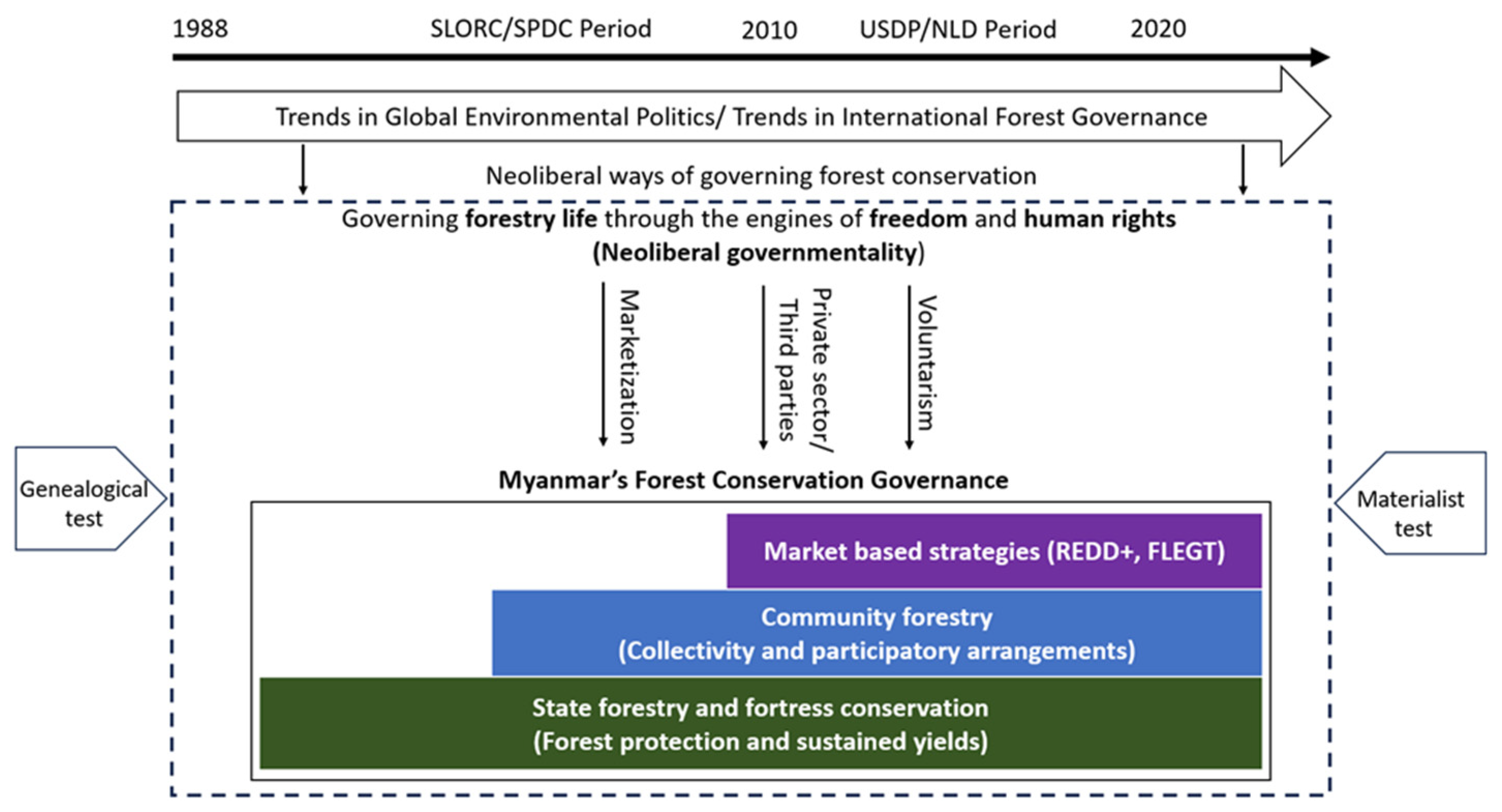
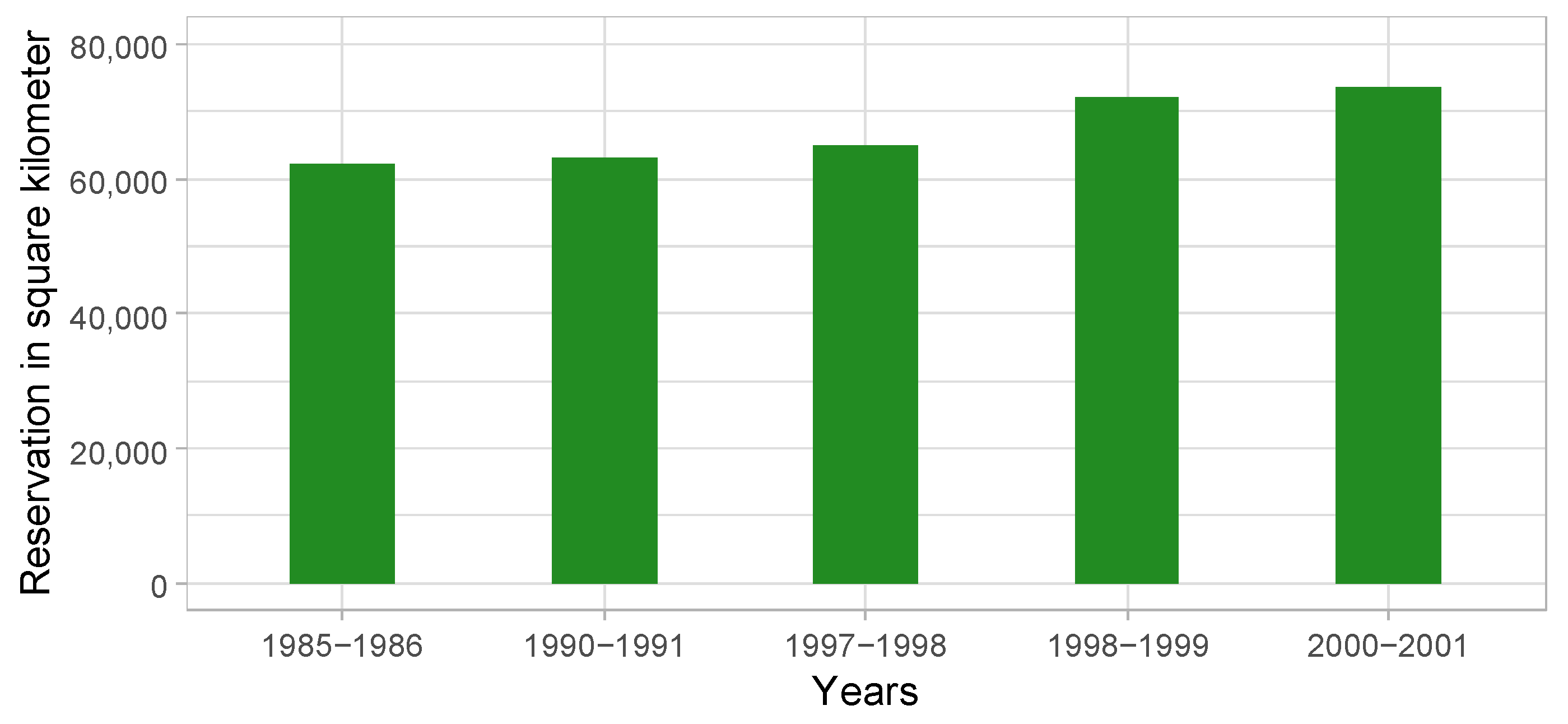
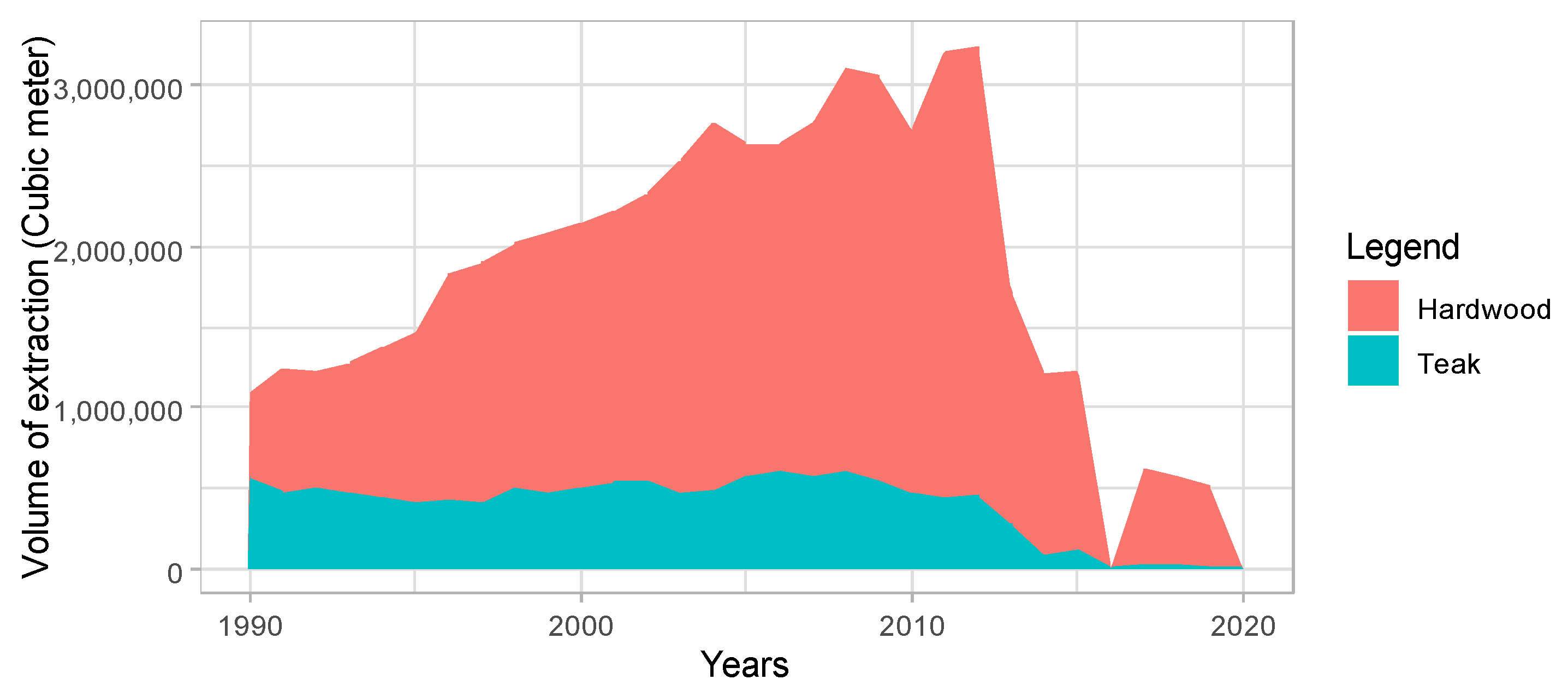
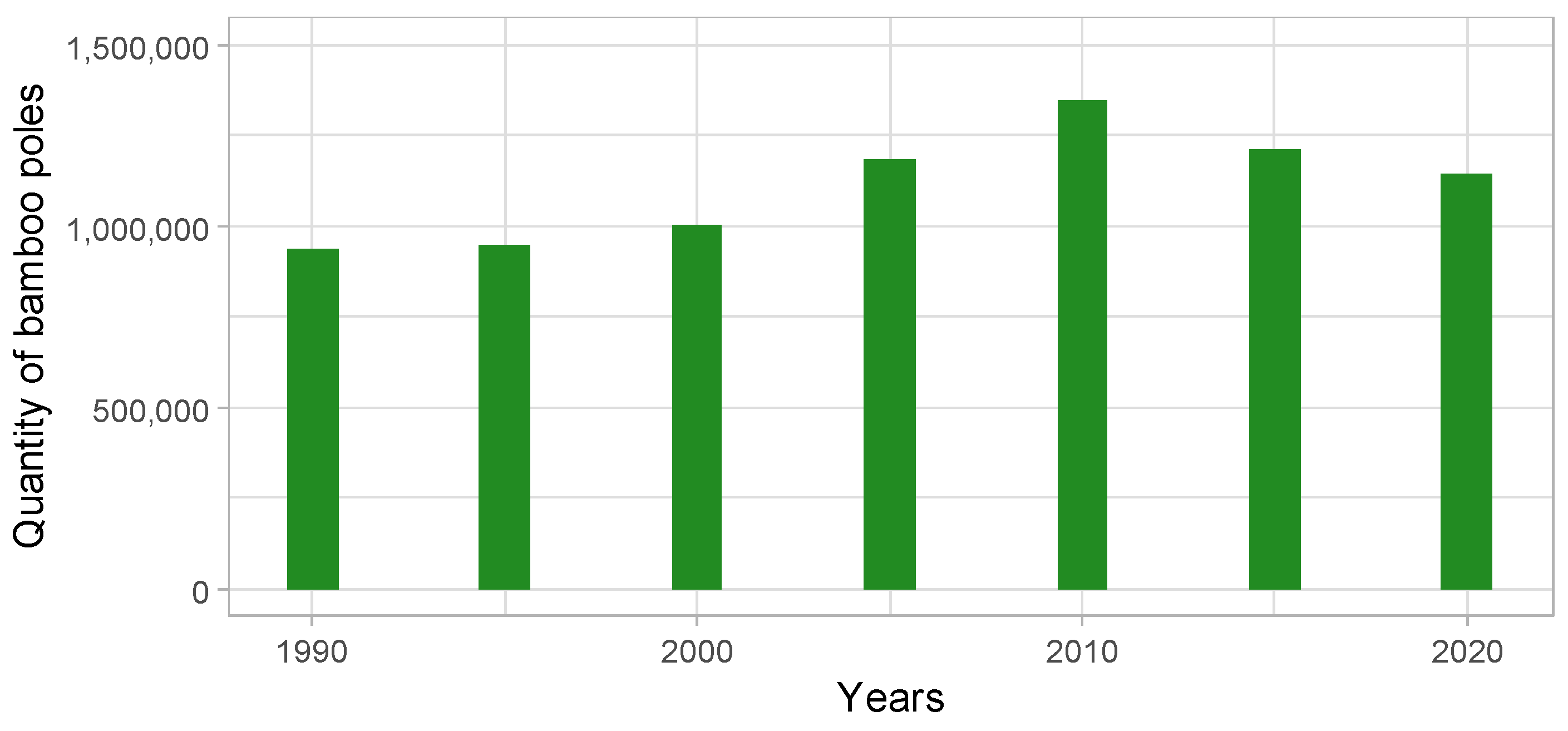
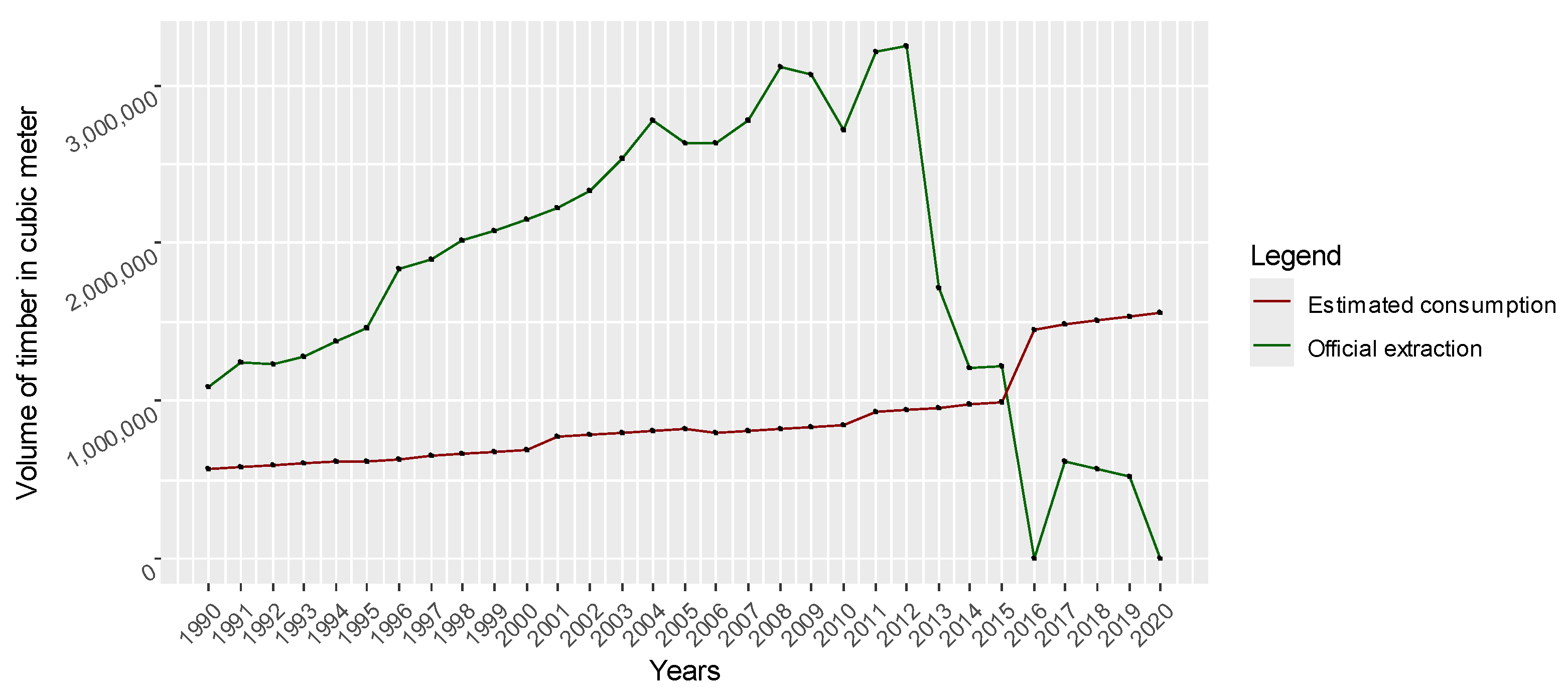

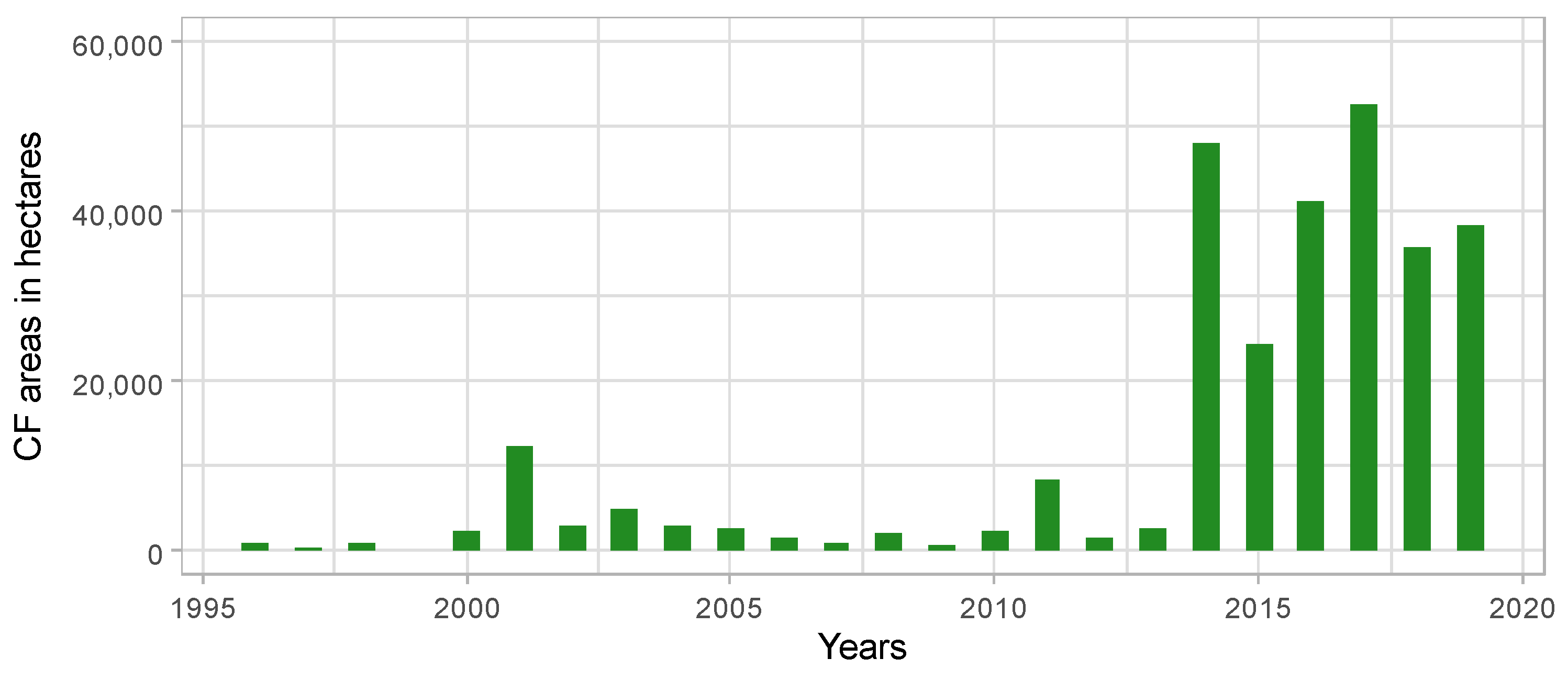

| Key Concepts | Description |
|---|---|
| Fortress conservation | It is a reservation-based approach to forest conservation, characterized by clearly marked boundaries and mapped areas under state forestry regimes, based on the logic that nature must be protected and the local population is seen as a threat. |
| Neoliberal conservation | Its core principles include the promotion of decentralization, deregulation, marketization, and an enhanced role for the private sector and third parties in forest conservation. |
| Community-based conservation | It promotes the logic of participation and collective action by local communities in forest conservation and management regimes. |
| Governmentality | It is a theoretical concept that explains the forestry phenomenon by examining the rationales of the state, its associated procedures and techniques in forest governance, as well as the counter-techniques employed by local communities to adapt to, adopt, resist, or overwrite state interventions. |
| Neoliberal governmentality | It is a concept that can explain how forest conservation is governed through the idealization of markets, the role of private and third-party systems, and the shaping of the perspectives of forestry actors and policymakers in both policymaking and the implementation of forestry actions. |
| Genealogy | It is a historical approach that seeks to scrutinize how various forestry ideas, knowledge systems, and beliefs were constructed over the analytical period of each study, and to examine how these came to be accepted as the most effective or truthful forestry practices to implement. |
| Discursive effect (Foucauldian perspective) | An effect that has influenced forestry policymaking and shaped the beliefs of various forestry actors through the production of forestry knowledge. |
| Materialist effect (Marxian perspective) | An effect triggered by the material conditions of forestry—such as deforestation rates, forest degradation, timber supply and demand dynamics, financial mechanisms, and the expansion of reservations—which has influenced forestry policymaking and shaped the beliefs of various forestry actors. |
Disclaimer/Publisher’s Note: The statements, opinions and data contained in all publications are solely those of the individual author(s) and contributor(s) and not of MDPI and/or the editor(s). MDPI and/or the editor(s) disclaim responsibility for any injury to people or property resulting from any ideas, methods, instructions or products referred to in the content. |
© 2025 by the authors. Licensee MDPI, Basel, Switzerland. This article is an open access article distributed under the terms and conditions of the Creative Commons Attribution (CC BY) license (https://creativecommons.org/licenses/by/4.0/).
Share and Cite
Paing, W.M.; Han, P.P.; Ota, M.; Fujiwara, T. “Skeletal Forest Governance” in Myanmar: The Interplays of Forestry Ideologies and Their Limitations. Conservation 2025, 5, 31. https://doi.org/10.3390/conservation5030031
Paing WM, Han PP, Ota M, Fujiwara T. “Skeletal Forest Governance” in Myanmar: The Interplays of Forestry Ideologies and Their Limitations. Conservation. 2025; 5(3):31. https://doi.org/10.3390/conservation5030031
Chicago/Turabian StylePaing, Win Min, Phyu Phyu Han, Masahiko Ota, and Takahiro Fujiwara. 2025. "“Skeletal Forest Governance” in Myanmar: The Interplays of Forestry Ideologies and Their Limitations" Conservation 5, no. 3: 31. https://doi.org/10.3390/conservation5030031
APA StylePaing, W. M., Han, P. P., Ota, M., & Fujiwara, T. (2025). “Skeletal Forest Governance” in Myanmar: The Interplays of Forestry Ideologies and Their Limitations. Conservation, 5(3), 31. https://doi.org/10.3390/conservation5030031






